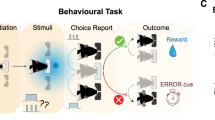Abstract
The process by which sensory signals are transformed into commands for the control of movement is poorly understood. A potential site for such a transformation is the superior colliculus (SC), which receives auditory, visual and somatosensory inputs1–3 and contains neurones that discharge before saccadic eye movements4–6. Along the primary sensory pathways, signals coding the spatial location of auditory, visual and somatosensory targets are based on distinctly different coordinate systems, and it is not known whether each type of sensory input uses a separate motor pathway or if they are converted into a common coordinate system in order to share a single pre-motor circuit. Sensory neurones in the SC have spatially restricted receptive fields (RFs) and are organized into maps across the collicular surface7–9. Acute experiments have shown a rough correspondence between the spatial positions of RFs of neurones encountered along a single dorsal–ventral penetration of the colliculus, regardless of the modality of the effective stimulus10–14, suggesting that auditory, visual and somatosensory maps might be in register. However, in these conditions the head-centred auditory system and the retinotopic visual system are aligned because the eyes are in the primary orbital position15. Moreover, other data have suggested16–18 that the primate SC is organized in motor, not sensory, coordinates, although in the cat, eye position was found to have no effect on auditory receptive fields19. We therefore sought here to determine what happens to the registration of the auditory and visual maps in the alert, behaving animal. Monkeys, with heads fixed, were trained to make delayed saccadic eye movements to auditory or visual targets from one of three initial fixation points while the activity of single neurones was recorded extracellularly. We found that the auditory receptive fields shifted with changes in eye position, allowing the auditory and visual maps to remain in register.
This is a preview of subscription content, access via your institution
Access options
Subscribe to this journal
Receive 51 print issues and online access
$199.00 per year
only $3.90 per issue
Buy this article
- Purchase on Springer Link
- Instant access to full article PDF
Prices may be subject to local taxes which are calculated during checkout
Similar content being viewed by others
References
Harting, J. K. J. comp. Neurol. 173, 583–612 (1977).
Edwards, S. B., Ginsburgh, C. L., Henkel, C. K. & Stein, B. E. J. comp. Neurol. 184, 309–330 (1979).
Fries, W. & Distel, H. Invest. Ophthal. vis. Sci. Suppl. 20, 74 (1981).
Schiller, P. H. & Koerner, F. J. Neurophysiol. 34, 920–936 (1971).
Wurtz, R. H. & Goldberg, M. E. J. Neurophysiol. 35, 575–586 (1972).
Sparks, D. L. Brain Res. 156, 1–16 (1978).
Dräger, U. C. & Hubel, D. H. Nature 253, 203–204 (1975).
Chalupa, L. M. & Rhoades, R. W. J. Physiol., Lond. 270, 595–626 (1977).
Palmer, A. R. & King, A. J. Nature 299, 248–249 (1982).
Wickelgren, B. G. Science 173, 69–72 (1971).
Gordon, B. J. Neurophysiol. 36, 157–178 (1973).
Dräger, U. C. & Hubel, D. H. J. Neurophysiol. 38, 690–713 (1975).
Stein, B. E., Magalhães-Castro, B. & Kruger, L. J. Neurophysiol. 39, 401–419 (1976).
Wise, L. Z. & Irvine, D. R. F. J. Neurophysiol. 49, 674–685 (1983).
Pöppel, E. Nature 243, 231 (1973).
Mays, L. E. & Sparks, D. L. J. Neurophysiol. 43, 207–231 (1980).
Sparks, D. L. & Mays, L. E. J. Neurophysiol. 49, 45–63 (1983).
Sparks, D. L. & Porter, J. D. J. Neurophysiol. 49, 64–74 (1983).
Harris, L. R., Blakemore, C. & Donaghy, M. Nature 288, 56–59 (1980).
Knudsen, E. & Konishi, M. Science 200, 795–797 (1978).
Fuchs, A. F. & Robinson, D. A. J. appl. Physiol. 21, 1068–1070 (1966).
Middlebrooks, J. C. & Pettigrew, J. D. J. Neurosci. 1, 107–120 (1081).
Wise, L. Z., Irvine, D. R. F., Pettigrew, J. D. & Calford, M. B. Neurosci. Lett. S8, S88 (1982).
Semple, M. N., Aitkin, L. M., Calford, M. B., Pettigrew, J. D. & Phillips, D. P. Hearing Res. 10, 203–215 (1983).
Jay, M. F. & Sparks, D. L. Neurosci. Abstr. 12, 951 (1982); Invest. Ophthal. vis. Sci. Suppl. 22, 82 (1983).
Author information
Authors and Affiliations
Rights and permissions
About this article
Cite this article
Jay, M., Sparks, D. Auditory receptive fields in primate superior colliculus shift with changes in eye position. Nature 309, 345–347 (1984). https://doi.org/10.1038/309345a0
Received:
Accepted:
Issue Date:
DOI: https://doi.org/10.1038/309345a0
This article is cited by
-
Visually guided saccades and acoustic distractors: no evidence for the remote distractor effect or global effect
Experimental Brain Research (2021)
-
Behavioral and neuronal study of inhibition of return in barn owls
Scientific Reports (2020)
-
Relative posture between head and finger determines perceived tactile direction of motion
Scientific Reports (2020)
-
Sounds are remapped across saccades
Scientific Reports (2020)
-
Flexible coding of object motion in multiple reference frames by parietal cortex neurons
Nature Neuroscience (2020)
Comments
By submitting a comment you agree to abide by our Terms and Community Guidelines. If you find something abusive or that does not comply with our terms or guidelines please flag it as inappropriate.



